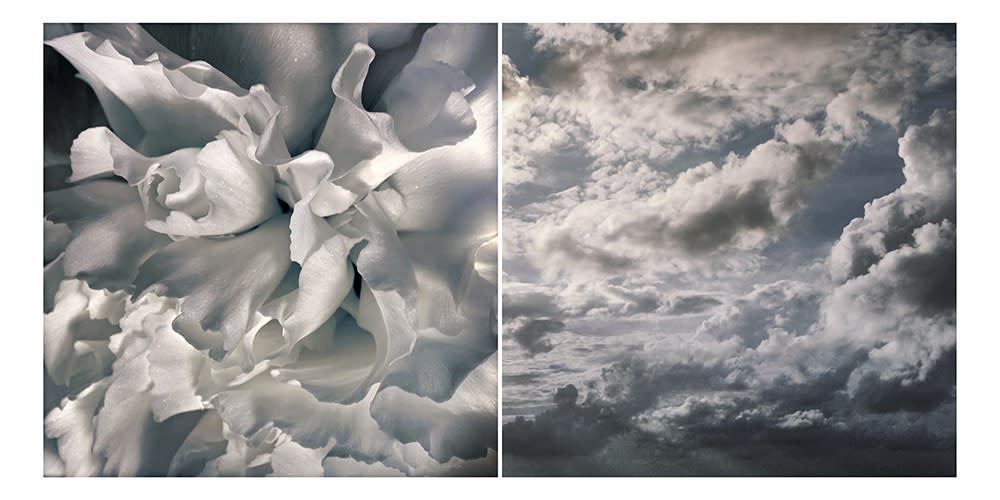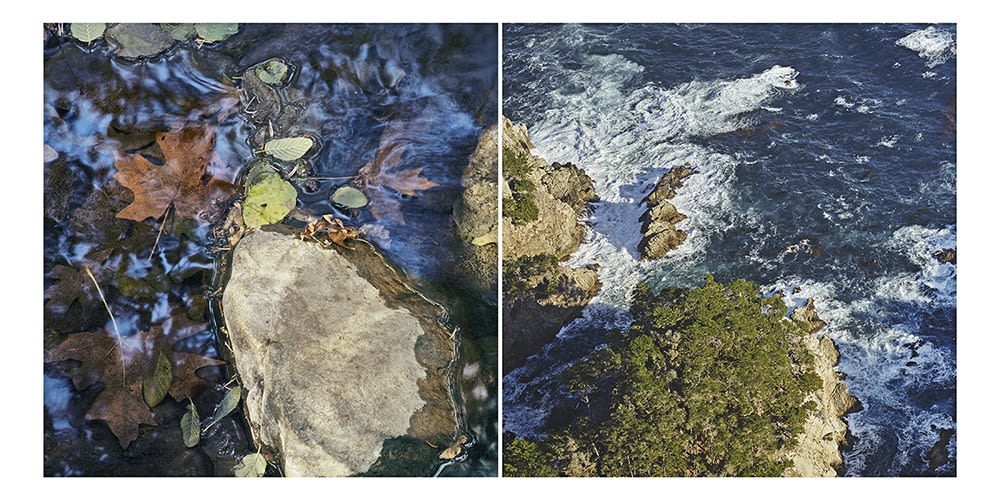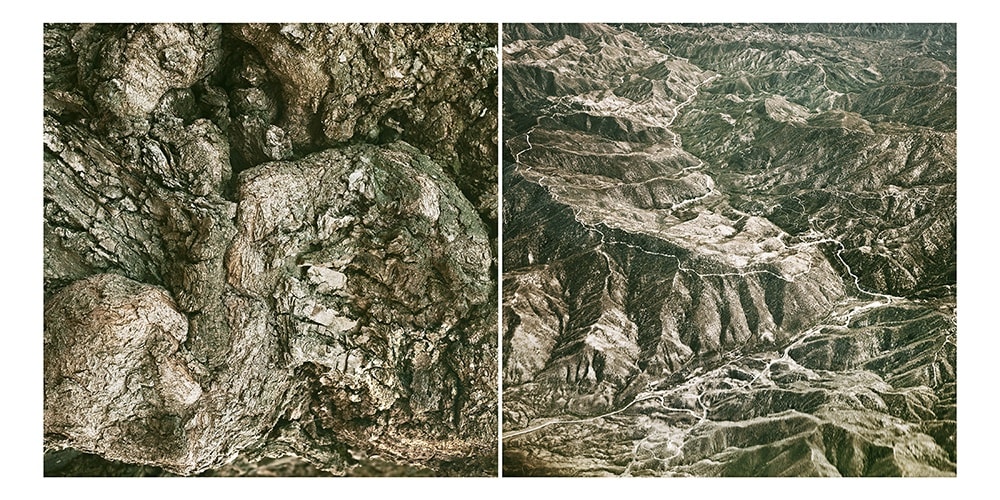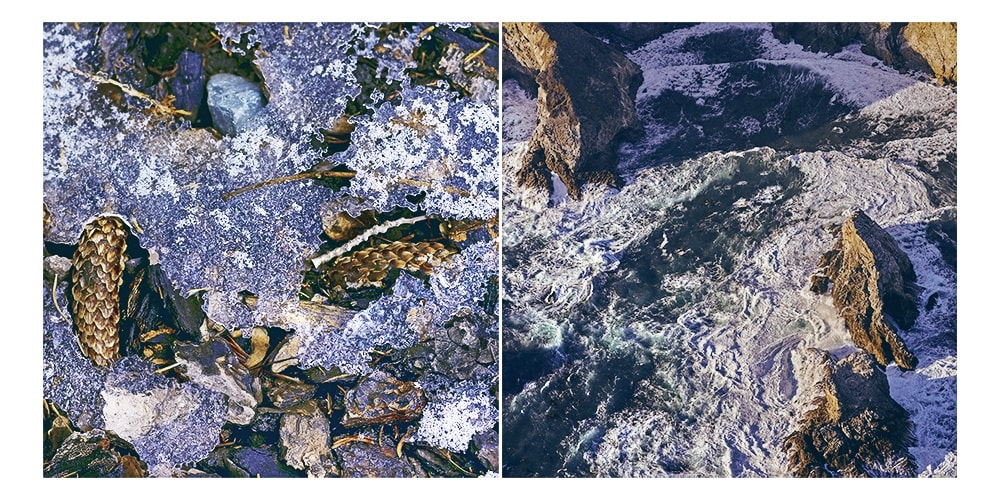
“Yet language is at best but a metaphor for what is experienced through vision” – James L. Enyeart (1)
Within the history of photography, multiple images have been combined to create a more flexible expression of what we see, with the thought that the combined presentation is a stronger metaphor for communication than each image separately. Julie Brook Alexander’s series “Filing in the Blanks” are diptychs, pairings of images that are from different places, taken at different times, and of completely different views of nature. Most are details from landscapes where patterns repeat, lines extend, and colors mirror. She uses these match-ups to make visual the inter-connectedness of our natural world. Each composition balances around a slim white line. That consciously placed and sized white space is reserved for the viewer to transition between a near, or close-in, vantage point photo, to one taken of a landscape or seascape from a far away distance. The use of intimate and infinite relative scales, patterns, lines, and colors bring a visual unity to the piece. That unity of two images, and two perspectives, is a visual metaphor to encourage the viewer to appreciate the unexpected connections in the world, that would not be achieved, in her view, within a single traditional (or straight) image.
Since the earliest days of photography, photographers made use of more than one image to build their creative vision and expression. In the 1850s, Gustave Le Grey combined two images, one image of the sky and one of land into a single image. In those days it was difficult to properly expose for both at the same time. The resulting image was a more true capture of what one saw than either image separately. Over time, other photographers used other techniques to combine multiple images into one, either in camera or layered negatives or positives together in various ways through the printing process. Photographers Ray K. Metzker, Richard Misrach, Dornith Doherty, David Hockney, and Jerry Uelsmann, among others, by her own account, influenced Alexander’s work. Building on the work of these artists, Alexander has moved her work forward into her own individual vision.
Ray K. Metzker experimented with combining two images. In John Szarkowski’s text “Looking at Photographs” he included the image “Untitled, 1968” from Metzker’s series “Sand Creatures”. The work captures, separately, two people asleep on the beach, in two separate images, arranged vertically into one presentation. Szarkowski commented in his writing about Metzker : “Most photographers have at one time or another discovered…exposures that have worked together to produce meanings distinct from those of individual pictures. These meanings may depend on the fortuitous confluence of associations, or on a surprising redefinition of spatial relationships, or both … (and) variations on a basic concept of cumulative meaning through multiple imagery, employing in various combinations multiple and overlapping exposures, sequential exposures, repetition of the same or similar negatives, repetition with variation of tone, and so on – all of these combined both photographically and mechanically.” (2) While Metzker’s subjects were people, Alexander’s images are of scenes of nature , in general, intentionally excluding people from the landscape. Another scholar , Keith F. Davis wrote that Metzker “… sought a new pictorial energy that evoked a fluidity of perspective, space and time”. (3)

In Alexander’s “Image 1”, the close up the white flower, and the distant capture of clouds and sky, seem to flow naturally into another. A sense of unity in nature is expressed, while at the same time, the gentleness in the flower and the softness of the clouds give a sense of comfort rather than tension. Combined, the two images cause the viewer to look more deeply and engage in the images rather than dismiss the images out of hand as: “Ok – an image of a flower”. Or, “Ok, an image of clouds like Steiglitz’s “Equivalents”, nothing new here”. Whether consciously of not, by taking a page from Metzker’s playbook, the combination of these natural objects from different perspectives has made something new.
Alexander’s work, “Filing in the Blanks”, is not about the image in each frame. The images selected are about something else. The paired images are about avoiding what city life brings with it: schedules that must be followed, routine, congestion, crowds, noise and complexity. In her pairings, one image is a close-up. The subject is tangible and recognizable. In some way it will connect to the “far away” or “big picture” image, figuratively speaking, not literally, as both images are the same print size. The subject matter is purposefully not the same place, and usually not the same subject matter. However, the place and/or subject matter do connect in some way. It is Alexander’s belief that all of us and these places and objects co-exist in the world in a positive way. Coming to one’s own sense of what that connectedness might be is the exercise and challenge for the viewer. It is that engagement with the image that takes the viewer away from their daily routines and demands. These images have virtually no industry or machines, nothing man-made, no crowds, and no animals, and if present, these are not the subject of the image.
Richard Misrach’s use of the landscape metaphorically rather than literally in his series “On the Beach” captured Alexander’s attention. The “On the Beach” work was discussed during an exhibition at the National Gallery of Art in 2008. (4) “Looking down from a hotel room directly adjacent to the beach, he has eliminated all references to the horizon and sky to record people immersed in the idyllic environment. Yet, despite the beauty of the scene, a strange sense of disquietude pervades these photographs. Made in the days immediately after September 11, 2001, these photographs speak of the unease and sense of foreboding that pervaded the country after the attacks on the World Trade Center and the Pentagon.” (5) Alexander’s use of the landscape is not dissimilar albeit under a different motivation. While Misrach’s work is a reaction to unease and foreboding, Alexander’s works create a search for comfort and unity in nature.

Image 2 by Alexander captures a traditional close shot of leaves that have fallen into a brook or stream adjacent to a photo from high on a cliff (or possibly an aerial photograph) of a shore line of rock and ocean waves. Both have blue water, but in one we see the ceaseless turmoil of waves crashing on a rocky shore and in the other a calm, slow, almost stationary looking stream. One has only evidence of trees in fall with the fallen brown, red and green leaves; and, the other full trees edging close to the cliff’s edge. A visual stage is set for the viewer to feel comfort and tension. Yet, there is also unity between the two images as all water flowing through creeks, brooks and streams, flow into rivers that flow ultimately into the ocean, and back again through rain, in an endless cycle. Just as the waves are constantly battering the shoreline, the cycle of life and death is constantly playing through of leaves dropping to the ground each fall season. In placing one image against the other, perhaps the viewer’s reaction will not just be: “Ok, leaves in a stream – nice”; or, “Nice shoreline image”. Just as Misrach’s “On the Beach” images are not a voyeuristic capture of people in water, but a metaphor for the permanent change in our world created by 9/11, so has Alexander sought to take a viewer to a place different from just a stream or shoreline.
The use of a near and far perspective may have been influenced by Texas photographer and educator Dornith Doherty, another artist that Alexander has said impacted her work. While Doherty may be best known for her “Archiving Eden: The Vaults” project, her images in the “Rio Grande: Burnt Water/Agua Quemada” series used two images to create one perspective. Curator Sara-Jayne Parsons wrote the following about Doherty’s work: “Dornith Doherty’s photographic series Burnt Water/Agua Quemada addresses … a complicated relationship between human agency and the natural environment. …The resulting images metaphorically reveal a natural region that is being reconfigured by a host of crucial and sometimes violent forces, including environmental politics, immigration, and economic inequities. And while they exist as re-visioned landscapes, her works are in fact straight photographs—a delicious secret that Doherty skillfully masks through a studio practice that eschews traditional documentary or expeditionary modes in favor of merging fact with aesthetics in a complicit reinvention of nature…”. (6) What Alexander appears to take from Doherty’s work is the the use of two images from different perspectives. Doherty takes a broad landscape image and then in her studio, she incorporates macro objects like “prickly pear plants, corn husks, soil, clothing, vinyl car seats, needles, and other found objects into the still-lifes to invoke the complexity of human experiences she had witnessed along the river, as well as refer to the immediacy of her personal experience within this landscape.” (7) These works created by Doherty contrast to Alexander’s work in that Doherty creates a singular image, and Alexander is using dual images in the style of Metzker’s “Sand Creatures”.

Image 3 demonstrates Alexander’s attention to color, textures and lines to unite two very different images. Both have a similar color tonal range of greens and patina of browns. In both the lines are flowing and curved with a rough course texture. The observer’s eye goes seamlessly from one to the other, pausing to realize that in one instance the view is very high above seemingly inhospitable mountains and then to a casual close examination of moss and tree bark. The harshness of this image contrasts sharply with Image 1. These differing textures create the different sensation that Alexander wants a viewer to experience and reflect upon. Because there are two works that are similar yet so different, the viewer cannot just passively walk by without giving the composition some thought. If one image is compared to another in the series, like with Misrach or Doherty, different perspectives are surfaced within a common theme.
In David Hockney’s work with photography, he combines multiple images in yet a very different way than Metzker, Misrach or Doherty. Hockney originally thought photography was deficient and not suitable for artistic efforts because it lacked the ability to reflect a sense of time and space. (8) The camera, in his initial view, only captured a frozen moment. In fairness, many thought that to be, as the case was made by Roland Barthe in his “Camera Lucida: Reflections on Photography”. To paraphrase what Hockney expressed, a viewer looks at an image longer than it took the camera to capture the image. However, he very creatively overcame this limitation of an image to metaphorically reflect movement through time and space, as Alexander has also tried to do, by using multiple images. Hockney’s methodology and reasoning is captured in an excellent documentary by John Paul Caponigro, himself a well-known photographer. By taking a series of photographs in a sequence from different focal lengths, near and far, as an activity is taking place, and taking in different areas of the scene, Hockney then took the separate unmanipulated images and collaged them into one work that he refers to as “Joiners”. In John Szarkowski’s text “Photography Until Now”, this same use of multiple images in Hockney’s work is seen in his “Stephen Spender, Mas Saint-Jerome. 1985”. It is a portrait of Spender’s face in a straw hat in a cubist-like arrangement of 8 images taken from different portrait perspectives and assembled together into a single collage of his face. There is the tension of seeing one image, but knowing the 8 different views are one person that we should recognize in this head & shoulders style facial portrait.” (9) Alexander admires Hockney’s effort to create a visual movement through time and space. The use of two images, one close and one far by Alexander captures that same sense of instantaneous movement as if we could physically just float from one position to another in relation to the two scenes.

Cold air can be felt in both frames of Image 4. On the left is a classic picture of snow or ice beginning to melt on the ground with the passing of time from winter into spring. There is little movement in the snow and ice as it melts into the ground below. There is delicacy on the left as we know how easily these ice formations break under the weight of our feet. The image on the right is an aerial view of a glacier, or massive snow, on a mountain. The mountain snow conveys heavy weight but slow imperceptible but inevitable movement with a commanding presence. It is an image that invites engagement to balance the different perspectives and ask oneself why the artist put these two images together? It is this thinking about the artist’s intention with a relaxed examination as to how the natural scenes selected are related that makes the image successful.
While very surrealistic, the penultimate master since the 1950s to the present of combining multiple images is Jerry N. Uelsmann. Robert Heineken was quoted in James L. Enyeart’s writing about Uelsmann: “There is vast difference between taking a picture and making a photograph”. (10) Peter C. Bunnell of Princeton University wrote about Uelsmann, “…the point of making art is to create an object that demands contemplation and reading…how the artist interprets the chaos of life, giving it meaning. How we are to perceive things with new eyes, new minds new awareness.” (11) Jerry Uelsmann himself wrote: “The problem is coming up with an image that some kind of substance or resonance that challenges the viewer with elements of enigma and mystery.” (12) These are the same motivations for Julie Brook Alexander.
Alexander, as other photographers, has used images like a metaphor of words or phrases applied to another word (or in this case, image) to which it does not necessarily relate directly and creates something abstract or symbolic of something else. In Alexander’s work she acknowledges a respect for the distinction between taking a picture and making a photograph. Each created image is worthy of contemplation and study. What Julie Brook Alexander has done is extend a path traveled by others to a different place by her choice of images to create that enigma, or riddle, for the viewer to think about more deeply.
Notes:
- “Jerry N. Uelsmann: Twenty-Five Years: A Retrospective”, by James L. Enyeart, Little, Brown & Company, 1982.
- From John Szarkowski’s “Looking at Photographs”, Museum of Modern Art, New York, 1973. P. 200
- “The Photographs of Ray K. Metzler”, Keith F. Davis, Yale University Press, 2012.
- The exhibition was organized by The Art Institute of Chicago. Elizabeth Siegel, associate curator of photography, Art Institute of Chicago, was curator. Sarah Greenough, senior curator of photographs, National Gallery of Art, coordinated the exhibition in Washington. There are a series of excellent recordings on the site available to hear the artist, Richard Misrach, discuss his work. The title of the series, On the Beach, is drawn from Nevil Shute’s cold war novel about nuclear holocaust. http://www.nga.gov/content/ngaweb/global-site-search-page.html?searchterm=misrach&category=Audio%2FVideo&pageNumber=1&lastFacet=category
- Op. Cit., NGA website for “Richard Misrach: On the Beach”.
- Essay by Sara-Jayne Parsons, Exhibitions Curator, Bluecoat, Liverpool, England, Published in FotoFest 2006: The Earth/Artists Responding to Violence pps104-107 http://dornithdoherty.com/gallery/rio-grande-burnt-water-agua-quemada/
- Op. Cit. Sara-Jayne Parson’s article.
- Watch an absolutely excellent video on “David Hockney_Joiners_Documentary” on John Paul Caponigro’swebsite “Illuminating Creativity”, January 11, 2014. http://www.johnpaulcaponigro.com/blog/12680/david-hockney-joiners/ During the interview in the documentary, we see Hockney talk about several compositions, two of which are “The Crossword Puzzle” and “Lunch at the British Embassy (Tokyo)”.
- John Szarkowski, “Photography Until Now”, The Museum of Modern Art, New York, 1989, page 278.
- “Jerry N. Uelsmann: Twenty-Five Years: A Retrospective”, by James L. Enyeart, Little, Brown & Company, 1982.
- “Other Realities” by Jerry Uelsmann, Bulfinch Press, 2005 with preface by Paul Karabinis and Forward by Peter C. Bunnell.
- Op. Cit., “Other Realities”. p. 45